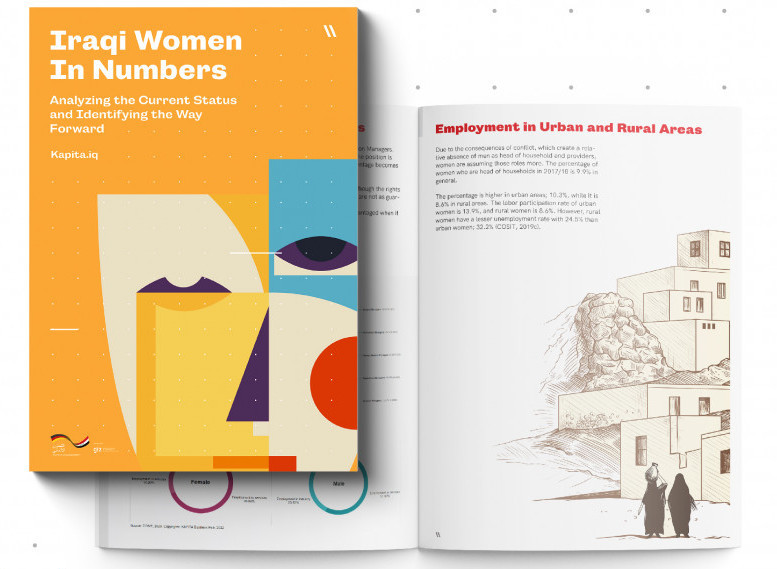Iraqi Women in Numbers: Analyzing the Current Status and Identifying the Way Forward
Women’s integration and full participation in society serve as a crucial part of the sustainable development of nations and are reflected in the economic growth of those nations.
Iraqi women represent half of the country’s population. However, this percentage is not reflected in the workforce participation nor in the equal access to resources and opportunities. According to the Global Gender Gap Report published by the World Economic Forum, Iraq has ranked 154 out of 156 countries in the Global Gender Gap Index for 2021 with a score of 0.53 out of 1, a score of 0.228 out of 1 in the economic participation, and a score of 0.8 out of 1 in educational attainment.
This report provides an overview of Iraqi women’s status from all the different aspects of demographics, education, employment and entrepreneurship, ICT skills, and health. It aims to provide the necessary information and data to draw a comprehensive picture of where women stand today in the Iraqi context.
Iraq has a relatively young population which totals, according to the estimated 2021 population, 41,190,658 of which there is an estimated female population of 20,380,179. That is 49.48% of the whole Iraqi population. The urban female population is 69.79% of the whole female population of Iraq, there is not much difference with the whole urban population which totals 69.87%.

This report also delves into women’s education. Iraq has the lowest female literacy rate amongst its neighbors, with 79.9%, as of 2017, below the global average of 83.3%. The total percentage of existing female primary school students in Iraq for the academic year 2019/20, excluding the Kurdistan region, is 47.42% of the total primary school students. While for secondary school it was 55.57%.
In the 2019/20 school year, 555,053 female students were admitted to the primary level, 48.63% out of the total enrollment rate in all public, private and religious schools. When it comes to secondary level education, 467,947 female students were admitted, 47.48% of the total enrollment rate.

Moreover, the report touches on the gender disparity in the workforce. According to data provided by the World Bank, the female labor force participation rate is 12.10% of the female population aged 15 and older. There is a wide gap between men and women in the labor force, as men’s participation is 76.70%.
As the graph indicates, there is a 20.8% gap between men's and women’s unemployment. This is an indicator of a deficiency in women's employment due to various aspects, being social boundaries or lack of skills, among others.
In addition, there is a very wide gap between the number of female employers to their male counterparts. Also, over the year 2017 to 2019, the percentage of female employers decreased from 0.4% in 2017 to 0.2% in 2019. This indicates that some factors are hindering women from climbing the career ladder.

In this research, we also cover the mistrust of the educational system, which indicates the outdated educational infrastructure in Iraq that is inadequate to prepare students and equip them with the necessary skills for the job market. College fell short as a source of knowledge of basic skills for respondents of both genders, but more specifically for women. However, overall, the difference between men's and women's basic ICT skills is insignificant indicating an equal footing between the two. A significant statistical difference was found between men and women in specialized ICT skills, where men were more equipped with those skills than women. However, this gap is redeemed in the programming skills, where neither of them is well-skilled.

Furthermore, the report explores the health context of Iraqi women. According to numbers provided by the World Bank, the female mortality rate in 2019 is 127.66 out of every 1,000 adult women. This is a decline from the previous decade; in 2009, it was 135.99 out of every 1,000. In contrast, in 2019, the adult male mortality rate is 184.46 out of every 1,000, while in 2009, it was 223.66 out of every 1,000.
The top ten causes of death for women are listed by the Iraqi Ministry of Health’s Statistical Annual Report of 2020 as follows, ischemic heart disease (IHD) is ranked as the first cause of death for women with 13.5% of deaths attributed to it and followed by cerebrovascular disease 10.5%, hypertensive diseases and malignant neoplasm 9.2%, other forms of heart diseases 7.3%, COVID-19 and renal failure 6.2%, diabetes mellitus 4.2%, respiratory and cardiovascular disorders specific to the perinatal period 3.5%, and other bacterial diseases 2%. Those causes of death are responsible for 71.8% of all female deaths in Iraq.
There is a correlation between early marriage and education that could be observed. In general, almost half of women who never attended school married early. Moreover, almost half of all illiterate women were married before turning 18. Women with secondary education and above reported only 6.8% of them had an early marriage, to 33.8% for uneducated women.

The report concludes by highlighting the main issues women encounter and draws on the recommendations that could mitigate those challenges. There must be a nationwide and systemic approach to the inclusion of women in the workforce and society. Private sector companies should work to attract and retain more women among their employees through implementing and monitoring policies that enable and empower women employees. This could be achieved by a wider reformation of the education system to equip women with ICT skills that would provide more career paths for women.
This report can be cited as:
KAPITA Business Hub. (2022, June 12). Iraqi Women in Numbers: Analyzing the Current Status and Identifying the Way Forward. KAPITA. Retrieved from: https://bit.ly/3xpZvVO






